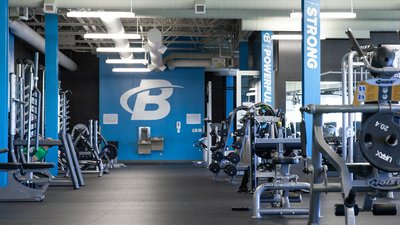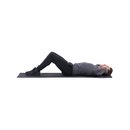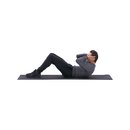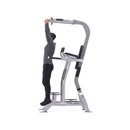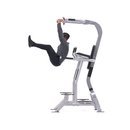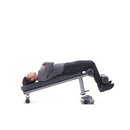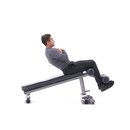One of the most sought-after body parts by trainers everywhere is abdominals. It seems everybody wants them, but few have them. Many toil away in the gym with sit-up after sit-up and crunch after crunch only to face sore abs and a declining motivation.
Others don't worry at all about their abs and neglect training them all together. They are many times seen as an after thought, tacked onto the end of a session only to be undertrained with little or no focus.
The abdominal area or midsection comprises of some significant functioning muscles. Not only does the midsection provide core stability and balance, it also aids in other lifts by redirecting pressure and stabilizing the entire trunk. By having the abs strong, the body can put more focus and energy toward a squat for example and hold in the pressure generated much like a weight belt.
Next time you are bench pressing flex your abs slightly and keep them tight throughout the lift - you will be surprised at the help you receive from your abs during both portions of the movement.
So not only are the abs a significant factor in actual functioning in regard to other movements in your routines, but they are also play a major role in the game of bodybuilding.
A competitive bodybuilder must posses a great set of abs in order to place well. Aesthetically speaking, the mind draws instantly to the abdominal region as they should present a balanced and proportionate physique. A ripped midsection also signifies that the athlete is in superior conditioning and helps to display the coveted V-taper.
Along with a sound eating plan and a comprehensive training regimen sculpted, ripped-up abs can become a reality. Although this article will focus on the actual training regimen, creating an impressive midsection takes an extensive and bodybuilding-friendly eating component as well. One cannot do countless sit-ups and leg lifts everyday and expect dramatic results.
No other body part requires such discipline to develop, but once they are uncovered and for all to see they are a sight to behold.
Quick Anatomy Lesson
The muscles of the abdominals comprise of several areas that flex, extend, twist and stabilize the trunk area. They sit on the front sides of the lower torso originating along the ribcage and attaching along the pelvis. Let's look at each muscle and its function.
- Rectus Abdominus: This is the coveted "six-pack" muscle - although it has more than six heads. This muscle flexes the spine and brings the ribcage and pelvis closer together.
- Transverse Abdominus: This muscle is a deep muscle of the core which lies beneath the other muscles that is essential for trunk stability.
- Internal & External Obliques: These are diagonal muscles that work to rotate the torso and stabilize the abdomen.
Chiseling Action
Now that you know a little about anatomy and function, let's delve into what makes outstanding abdominals. The movements and routines presented are designed to get the most out of each trip to the gym.
Remember to always use good form and not to use too much weight to compromise your safety. Remember when performing any abdominal movement be sure to execute each motion (concentric and eccentric) with steadfast control to avoid ballistic-style reps.
Crunches & Sit-ups
The basic crunch is performed while lying on the floor with your feet flat on the ground, arms either crossed in front of you or hands behind your head and crunching your upper body toward your knees. Your lower back should not come off of the ground, just your upper torso. Crunch your abs and exhale as you come up. Squeeze for a second and then return without taking tension off of the midsection.
For sit-ups assume the same starting position then curl up your entire upper body into your knees. Uncurl and return to the starting position. Try not to use your lower back, instead let your abs curl you up.
Quick Hit: There are many forms of the crunch to choose from such as performing them on a flex-ball, feet supported on a bench, and weighted by holding a small weight plate on your chest. Another way to try weighted crunches is to lie on the floor with your head toward a rope attachment on a low pulley and pull the weight up while you crunch. Make sure to hold the ends of the rope on either side of your head when crunching.
A great way to make the sit-up more difficult is to perform them on a decline bench and hold a weight plate on your chest with crossed arms. This would be a bit of a challenge, so try it with a weight you can handle first.
Leg Raises
The leg raise is performed while lying face up on the ground with your hands slightly out to your sides palms down on the floor for support. With your feet together, lift your legs with a slight bend in the knees until they are just short of perpendicular to the floor. Lower to the starting position without letting your heels touch the floor and repeat.
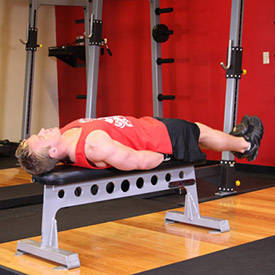
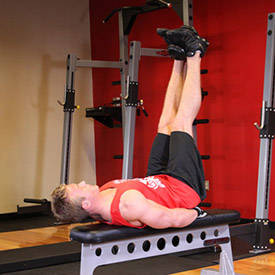
Quick Hit: For a more of a challenge leg raises can be performed on a decline bench. This will require you to raise your legs over a wider range of motion for a more difficult and effective contraction.
Hanging leg raises or knee raises are two more alternatives to really hammer the lower abs. While hanging from a chinning bar raise up your legs as in the lying raises and stop when your legs are at parallel with the floor and return. For knee raises bring your knees into you abdominal region until they are past parallel and squeeze. Lower and return as with leg raises.
Side Crunches
Lay down on the floor on your side with both hands behind your head - use a foot support if necessary to stabilize your lower body. Crunch up on your side while your hip remains in contact with the floor. Squeeze at the top for a second and then return to the starting position and avoid resting your upper body. Switch sides and repeat.
Bicycles
As one of the most effective ab exercises out there (especially for the obliques) the bicycle is not only challenging, but when done correctly, can grant you great overall ab development.
Lie on the ground with your hands behind your head and your feet slightly off of the ground. Start alternating your elbows to knees. Twist your torso so that your left elbow reaches your right knee and then vice versa. Keep alternating while keeping your shoulders off of the floor. Squeeze the obliques with every contraction.
Quick Hit: You can make this movement a bit more challenging and isolate one set of obliques at a time by focusing on one side and then switching over to the other. Just perform all reps for one side then switch and do the allotted number of reps for the other.
Russian Twists
This movement is not for the weak at heart. Seat yourself on a Roman chair or a decline sit-up bench where your upper body is suspended.
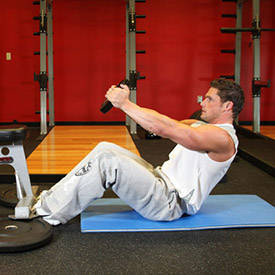
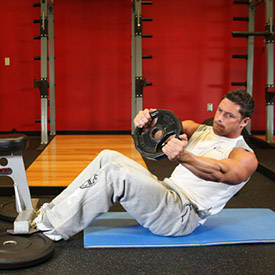
Hold a weight plate or medicine ball out in front of you with your arms straight. You will begin to twist only your upper torso to one side as far as you can comfortably go then twist to the other. Keep twisting - but keep the movement somewhat at a slow pace. You do not want to jerk the weight around and injure your lumbar in any way.
Quick Hit: For those that find it difficult utilizing a weight plate or medicine ball with this movement simply clasp your hands in front of you and perform the exercise as usual. This will build up your strength so you may graduate up to using weight in the future.
Plank
Utilized as a standard for core strength and development, the plank is not a movement at all. It is a stability exercise used mainly to build the transverse abdominus.
Simply assume a standard push-up position except hold yourself up by your elbows instead of your hands. Keep your stomach tight and drawn in slightly to activate your core muscles. Hold this position for 20 to 30 seconds and then rest - this will be counted as one set.
Side Plank
Much like the plank, the side plank works the core but on either side for lateral stability. With your body straight lie on your side while holding yourself up by you elbow and your feet together. You can place your other arm either straight down your other side or on your waste. Again, hold the position for 20-to-30 seconds and repeat for the other side.
Quick Hit: To give you a bit more of a challenge, try switching from a side plank to a normal plank over to another side plank slowly. Be sure to keep the body aligned and perform the movement in a steady, fluid motion.

BodyFit
$6.99/month- 2,500+ expert-created single workouts
- 3,500+ how-to exercise videos
- Detailed workout instruction
- Step-by-step workout tips
- Training at gym or at home
- Access to Workout Plans
- Access to Bodyfit App
- Store Discounts
Already have a Bodybuilding.com account with BodyFit? Sign In

What comes with BodyFit?

- Instructional Videos
Don't risk doing a workout improperly! Avoid injury and keep your form in check with in-depth instructional videos.

- How-to Images
View our enormous library of workout photos and see exactly how each exercise should be done before you give it a shot.

- Step-by-Step Instructions
Quickly read through our step-by-step directions to ensure you're doing each workout correctly the first time, every time.

BodyFit
$6.99/month- 2,500+ expert-created single workouts
- 3,500+ how-to exercise videos
- Detailed workout instruction
- Step-by-step workout tips
- Training at gym or at home
- Access to Workout Plans
- Access to Bodyfit App
- Store Discounts
Already have a Bodybuilding.com account with BodyFit? Sign In

What comes with BodyFit?

- Instructional Videos
Don't risk doing a workout improperly! Avoid injury and keep your form in check with in-depth instructional videos.

- How-to Images
View our enormous library of workout photos and see exactly how each exercise should be done before you give it a shot.

- Step-by-Step Instructions
Quickly read through our step-by-step directions to ensure you're doing each workout correctly the first time, every time.

BodyFit
$6.99/month- 2,500+ expert-created single workouts
- 3,500+ how-to exercise videos
- Detailed workout instruction
- Step-by-step workout tips
- Training at gym or at home
- Access to Workout Plans
- Access to Bodyfit App
- Store Discounts
Already have a Bodybuilding.com account with BodyFit? Sign In

What comes with BodyFit?

- Instructional Videos
Don't risk doing a workout improperly! Avoid injury and keep your form in check with in-depth instructional videos.

- How-to Images
View our enormous library of workout photos and see exactly how each exercise should be done before you give it a shot.

- Step-by-Step Instructions
Quickly read through our step-by-step directions to ensure you're doing each workout correctly the first time, every time.

BodyFit
$6.99/month- 2,500+ expert-created single workouts
- 3,500+ how-to exercise videos
- Detailed workout instruction
- Step-by-step workout tips
- Training at gym or at home
- Access to Workout Plans
- Access to Bodyfit App
- Store Discounts
Already have a Bodybuilding.com account with BodyFit? Sign In

What comes with BodyFit?

- Instructional Videos
Don't risk doing a workout improperly! Avoid injury and keep your form in check with in-depth instructional videos.

- How-to Images
View our enormous library of workout photos and see exactly how each exercise should be done before you give it a shot.

- Step-by-Step Instructions
Quickly read through our step-by-step directions to ensure you're doing each workout correctly the first time, every time.


